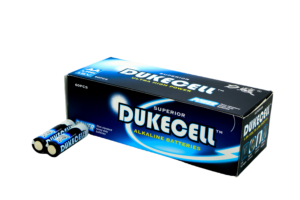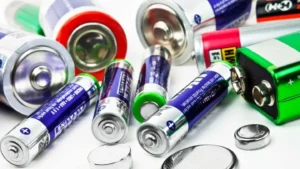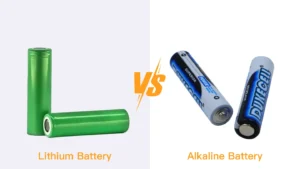Whether you’re powering a flashlight, a wireless mouse, or a smoke detector, choosing between lithium vs alkaline batteries can significantly affect performance, reliability, and upfront cost. Battery alkaline chemistries use zinc–manganese dioxide (Zn/MnO₂) and deliver 1.5 volts per cell, designed for single use. Lithium batteries—such as lithium iron (Li-FeS₂) or lithium ion batteries—offer up to 2–3x higher energy density, support voltages up to 3.7V, and are often rechargeable. Lithium ion batteries also maintain voltage more consistently in high drain devices or extreme temperatures, making them ideal for demanding applications. Alkaline counterparts, on the other hand, remain a cost-effective choice for everyday needs where power demand is low.
In this guide, we’ll explore the chemistry, applications, and technical specs of lithium vs alkaline batteries—so you can make an informed decision.

Chemical Makeup
The core difference between lithium and alkaline batteries lies in their chemical makeup—and that chemistry drives everything from performance to safety and upfront cost.
Alkaline batteries

Battery alkaline cells use a zinc anode and manganese dioxide (MnO₂) cathode, delivering a nominal voltage of 1.5V per cell. AA batteries based on alkaline chemistry typically offer between 2,400 and 2,800 mAh in low-drain conditions (under 100mA), but under high-drain loads (500mA or more), the usable capacity can drop by up to 50%. The output voltage declines progressively during discharge, which limits performance in high drain devices. In extreme temperatures, such as 0°F (-18°C), capacity loss can reach 25–30%. Shelf life typically ranges from 5 to 7 years.
Lithium batteries

Lithium batteries, including lithium iron (Li-FeS₂) for primary cells and lithium ion batteries for rechargeables, rely on lithium-based chemistries that provide high performance, flat discharge curves, and greater durability. For example, a primary lithium or alkaline battery in AA size using lithium chemistry can offer 2,900–3,200 mAh, maintaining a steady 1.7–1.8V output for most of the cycle. Lithium batteries also operate reliably across a wide range of conditions, from -40°F to 140°F (-40°C to 60°C), with only 5–10% capacity loss in sub-zero settings.
Lithium ion batteries vary by battery type. Common variants include NMC (nickel manganese cobalt oxide) used in electronic devices, and LFP (lithium iron phosphate), known for thermal stability and long cycle life. NMC types typically last 300–500 cycles, while LFP cells can exceed 2,000 cycles under controlled depth-of-discharge and temperature conditions.
From an environmental standpoint, alkaline counterparts are often considered disposable batteries and are landfill-safe in most regions. However, due to their single-use nature, they contribute more to waste. In contrast, lithium batteries offer a more environmentally friendly option when used in rechargeable formats and properly recycled through approved facilities.
In terms of cost, battery alkaline cells typically retail for $0.50–$0.70, while comparable lithium and alkaline models with lithium chemistry cost $1.50 to $3.00 each. However, in high drain devices or extreme temperatures, lithium batteries offer better power retention and longer lifespan—making them a more cost effective solution for demanding power requirements.
The chemistry-based advantages make lithium or alkaline battery choices very situational: lithium batteries offer superior reliability in outdoor gear, medical monitors, and tactical flashlights, while alkaline counterparts still serve well in electronic devices with modest power needs like remotes, clocks, and toys.
Sizes

Battery size isn’t just about physical dimensions—it also determines voltage, capacity, and power requirements. Both battery alkaline and lithium and alkaline battery types are available in a wide range of formats to suit various electronic devices.
AA batteries based on alkaline chemistry—also referred to as LR6 under the IEC system—typically deliver 1.5V and offer 2,400 to 2,800 mAh in low-drain applications. However, these disposable batteries may lose up to 50% of their capacity when used in high drain devices. In contrast, lithium iron (Li-FeS₂) AA batteries deliver 1.7–1.8V, with a higher capacity of 2,900 to 3,200 mAh, and maintain high performance even in extreme temperatures, with only 5–10% capacity loss at -20°C to -40°C.
For coin cells, alkaline counterparts like LR44 offer 1.5V and limited capacity (~110 mAh), while lithium batteries offer superior alternatives such as CR2032, delivering 3V and around 220–240 mAh.
Rechargeable lithium ion batteries come in multiple battery type formats. Popular models include:
18650: 18mm × 65mm, 2,000–3,500 mAh
21700: 21mm × 70mm, up to 5,000 mAh
14500: Similar size to AA, 800–1,200 mAh
These cylindrical cells are commonly found in flashlights, laptops, and e-bikes. Unlike battery alkaline formats, which are mostly limited to household sizes, lithium batteries offer a cost effective and environmentally friendly solution across more applications—especially where long runtime, rechargeability, or rugged conditions matter.
See the table below for a side-by-side comparison of common battery types, including chemistry, nominal voltage, and capacity range.
| Model | Chemistry | Rechargeable | Voltage | Capacity (mAh) | Use Case |
| AA (LR6) | Alkaline | No | 1.5V | 2,400–2,800 | Remotes, toys |
| AA (Li-FeS₂) | Lithium Primary | No | 1.7–1.8V | 2,900–3,200 | Flashlights, sensors |
| CR2032 | Lithium Coin Cell | No | 3.0V | 220–240 | Watches, key fobs |
| 18650 | Lithium-ion | Yes | 3.6–3.7V | 2,000–3,500 | Flashlights, e-bikes |
| 21700 | Lithium-ion | Yes | 3.6–3.7V | 4,000–5,000 | Power tools, high-performance gear |
Where Each Battery Is Used

Common applications for different battery types and sizes.
Alkaline Batteries – Best for Basic Everyday Use
AA (LR6): Remotes, wall clocks, wireless mice, toys; 1.5V, ~2,500 mAh. Reliable for light, continuous use.
AAA (LR03): Slim remotes, thermometers, fitness trackers; 1.5V, ~1,000–1,200 mAh. Ideal for compact, low-drain electronics.
C (LR14) / D (LR20): Flashlights, radios, toys needing more power; 1.5V, high current support.
9V (6LR61): Smoke detectors, walkie-talkies, medical alarms; multi-cell format, ~500–600 mAh.
Lithium Primary Batteries – For Power and Extreme Conditions
AA (Li-FeS₂): Digital cameras, GPS trackers, outdoor sensors; 1.7V, 2,900–3,200 mAh. Performs well at -40°F and in high-drain loads.
CR2032: Key fobs, wearables, glucose monitors, motherboards; 3V, ~220 mAh. Long shelf life, low self-discharge.
CR123A: Tactical flashlights, security systems, industrial sensors; 3V, ~1,500 mAh. Compact size with high output and up to 10-year shelf life.
Rechargeable Lithium Ion Batteries – Built for High-Drain Devices
18650: Flashlights, e-bikes, laptops, cordless tools; 3.6V, 2,000–3,500 mAh. Long cycle life, stable under load.
21700: Drones, power stations, high-performance gear; 3.7V, up to 5,000 mAh. Higher energy density in a slightly larger cell.
14500: LED pens, compact flashlights, smart gadgets; same size as AA, 3.7V, ~800–1,200 mAh. Rechargeable alternative for AA-sized electronics.
Quick Tip:
Use battery alkaline cells for low-cost, low-drain situations. For outdoor gear, cold weather, or power-hungry electronic devices, lithium batteries offer better runtime, lighter weight, and higher reliability.
In our experience, CR123A is one of the most underrated batteries for home security and tactical gear.
Storage and Recycling

Proper storage and end-of-life handling don’t just extend battery shelf life—they help reduce safety risks and environmental harm. While both battery alkaline and lithium batteries can last for years, they require different precautions and disposal methods.
Battery alkaline cells, like AA batteries such as LR6 or LR03, should be stored in a cool, dry place at room temperature, ideally below 77°F (25°C) with low humidity. These disposable batteries have a shelf life of 5 to 7 years and are generally stable when unused. In most U.S. states, it’s legal to throw batteries in the trash, but certain states—like California and Vermont—classify them as household hazardous waste. When unsure, recycling is a cost effective and safer alternative.
Lithium and alkaline formats containing lithium—especially lithium ion batteries—must be handled more carefully. This battery type should be stored between 68°F and 77°F (20°C to 25°C), away from heat, moisture, and metal objects. Cells showing swelling, punctures, or overheating are at risk of thermal runaway and must be isolated immediately. Some formats, like CR123A or 18650, are considered Class 9 hazardous materials and must follow DOT regulations in transit or bulk storage.
Recycling lithium batteries is not optional—it’s mandatory in many states due to their reactive materials and fire risk. Programs like Call2Recycle help users find local drop-off points. Many major retailers, including Home Depot, Best Buy, and Staples, accept used lithium ion batteries and rechargeable batteries for proper disposal.
Improper disposal not only violates local laws—it puts your home and community at risk. If your area offers collection programs, use them. It’s safer, smarter, and more environmentally friendly.
Alkaline batteries are reliable and cost effective for low-drain, everyday use, while lithium batteries offer longer life and better performance in high drain devices and extreme temperatures.
Choosing the right battery type helps you optimize performance, reduce waste, and extend device longevity.
Dukecell is a professional battery manufacturer of both battery alkaline and lithium ion batteries, serving consumer, industrial, and custom applications with OEM, wholesale, and private label solutions.
Talk to our battery experts to get tailored advice or request a quote today.




